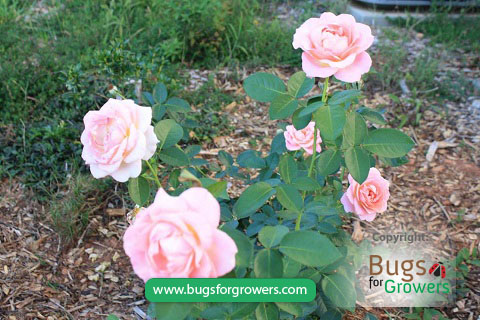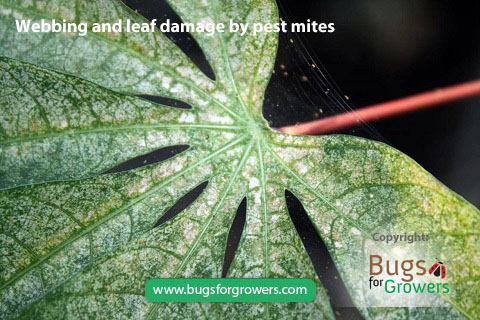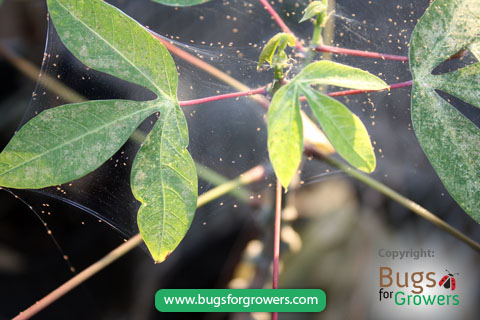Predatory mites- Bugsforgrowers.com
There are two types of mites found in the nature. The mites that feed on plants are considered as pest mites whereas those feed on pest mites as well as on some small insects like thrips are considered as predatory mites. These both types of mites are closely related to spiders but not to the insects because like spiders, they have four pairs of legs but insects have only three pairs of legs. Both pest and predatory mites naturally occur in different cropping systems including vegetables, cotton, soybeans, corn, and fruit trees, and in nurseries on ornamental plants. While pest mites are damaging plants, predatory mites may be enjoy feasting on them.
There are several economically important species of pest mites (See below) that cause a serious damage and reduce the yield of a wide range of crops that are grown in greenhouses, nurseries and fields. The pest mites can also damage many ornamental plants including roses (Photo 1) and trees that are grown in various types of landscapes (back yards and recreational parks) and forests, respectively.

Important species of pest mites
- Apple rust mite, Aculus schlechtendali
- Avocado mite, Oligonychus perseae
- Brevipalpus citrus mite, Brevipalpus californicus
- Broad mites, Polyphagotarsonemus latus
- Carmine red mite, Tetranychus cinnabarinus
- Citrus red mite, Panonychus citri
- Cyclamen Mite, Phytonemus pallidus
- European red mite, Panonychus ulmi
- Pacific mite, Tetranychus pacificus
- Six-spotted mite, Eotetranychus sexmaculatus
- Southern red mite, Oligonychus ilicis
- Tomato russet mite, Aculops lycopersici
- Two-spotted spider mite, Tetranychus urticae
Plant damage by pest mites
All the species of pest mites mainly feed by sucking cell sap (juice) from leaves of their host plants. Feeding injury by pest mites generally gives mottled and speckled appearances (Photo 2) to leaves. Also, heavy infestation of mites can cause yellowing and drying of leaves, pre-mature leaf drop, plant death and yield loss of many crops. Also, while feeding, some species of pest mites like two-spotted spider mite (Tetranychus urticae) generally produce webbing (Photo 3) on plants that reduces aesthetic value of many ornamental plants like roses. The feeding activity of mites also affects the photosynthesis and thus reduces plant’s ability to make its own food.


Chemical control of pest mites
There are several kinds of chemical pesticides called as Acaricides are available in the market for controlling of pest mites but their use in the greenhouses, nurseries and fields may be restricted due to their detrimental effects on humans and the environments.
Biological control of pest mites with predatory mites
Predatory mites are considered as best biological alternatives to chemical pesticides (Acaricides) because they are not harmful to humans and the environment. Several naturally occurring species of predatory mites are known to feed on pest mites. When the population densities of pest mites are at low level, the naturally occurring predatory mites can effectively keep the population of pest mites down and reduce the damage caused by them. However, in case of heavy infestation of pest mites, we need to supplement the low numbers of the naturally occurring predatory mites with a very high the numbers of commercially produced predatory mites to combat the heavy infestation of pest mites.
Currently following four different species of predatory mites are commercially produced and marketed as excellent biological control agents for the effective control of different species of pest mites that are causing a severe damage to many crops and plants grown in the fields, greenhouses, nurseries and orchards.
Four predatory mites as biological control agents
- Predatory Mite, Amblyseius swirskii
- Predatory Mite, Neoseiulus californicus
- Predatory mite, Neoseiulus fallacis
- Predatory Mite, Phytoseiulus persimilis
Important biological attributes of Amblyseius swirskii
- Naturally occurring species
- Commercially available
- Can feed on nymphs and adults of pest mites
- Release 4-5 predatory mites per square feet (0.1 sq. meter) area 2-3 times bi-weekly
- Release over 5000 predatory mites per acre 2-3 times bi-weekly
- As a preventive measure release predatory mites before incidence of pest mites
- As a curative measure release them after incidence of pest mites
- Warm adapted – optimum temperature for their normal reproduction and development is between 20°C (68°F) and 29°C (84.2°F)
- Sluggish under cooler temperatures but resume activity when temperature rises.
- Do not survive under really cold and frosty conditions
- Do not undergo diapause due to short day-lengths or low temperatures
- Therefore, they can be released in the late fall and in the winter on indoor plants
- Effective against following pest mite
- Tomato russet mite, Aculops lycopersici
- Two-spotted spider mite, Tetranychus urtica
Important biological attributes of Neoseiulus californicus
- Naturally occurring species
- Commercially available.
- Adults are clear white with four pairs of legs
- Females lay 40- 45 egg
- Eggs hatch into tiny nymphs
- Nymphs are translucent in color and develop as protonymphal and deutonymphal stages.
- Both nymph stages resemble to their parents
- Each adult mite can eat 5 eggs of pest mites within a day.
- Also, feed on nymphs and adults of pest mites
- Release 4-5 predatory mites per square feet (0.1 sq. meter) area 2-3 times bi-weekly
- Release over 5000 predatory mites per acre 2-3 times bi-weekly
- As a preventive measure release predatory mites before incidence of pest mites
- As a curative measure release them after incidence of pest mites
- Effective against following pest mites
- Apple rust mite, Aculus schlechtendali
- Avocado mite, Oligonychus perseae
- Broad mites, Polyphagotarsonemus latus
- Cyclamen Mite, Phytonemus pallidus
- European red mite, Panonychus ulmi
- The southern red mite, Oligonychus ilicis
- Tomato russet mite, Aculops lycopersici
- Two-spotted spider mite, Tetranychus urtica
Important biological attributes of Neoseiulus fallacis
- Naturally occurring species
- Commercially available
- Adults are pear shaped with four pairs of legs
- Depending upon the prey, adults can be red or brown colored
- Females lay over 60 eggs on underside of leaves
- Eggs hatch into tiny nymphs
- Nymphs develop as protonymphal and deutonymphal stages.
- Nymphs (larvae) resemble to parents
- The optimum temperature for normal reproduction and development is between 21 and 38°C (70-100°F) and relative humidity is between 40-60%
- Feed on eggs, nymphs and adults of pest mites
- Adults can eat 15 pest mites per day
- Release 4-5 predatory mites per square feet (0.1 sq. meter) area 2-3 times bi-weekly
- Release over 7000 predatory mites per acre 2-3 times bi-weekly
- As a preventive measure release predatory mites before incidence of pest mites
- As a curative measure release them after incidence of pest mites
- Effective against following pest mites
- Broad mites, Polyphagotarsonemus latus
- Brevipalpus citrus mite, Brevipalpus californicus
- Carmine red mite, Tetranychus cinnabarinus
- Citrus red mite, Panonychus citri
- Cyclamen Mite, Phytonemus pallidus
- European red mite, Panonychus ulmi
- Pacific mite, Tetranychus pacificus
- Six-spotted mite, Eotetranychus sexmaculatus
- Southern red mite, Oligonychus ilicis
- Tomato russet mite, Aculops lycopersici
- Two-spotted spider mite, Tetranychus urticae
Important biological attributes of Phytoseiulus persimilis
- Naturally occurring species
- Commercially available
- Adults are orange in color
- Females lay over 60-80 eggs among pest mite colonies
- Eggs hatch into tiny nymphs
- Nymphs develop as protonymphal and deutonymphal stages.
- Nymphs (larvae) resemble to parents
- These mites can reproduce and develop within 5 and 25 and days if temperature is about 30°C (86°F) and 15°C (59°F)
- Feed on eggs, nymphs and adults of pest mites
- Adults can eat 25 eggs, 15 nymphs and 5 adults of pest mites per day
- Release 4-5 predatory mites per square feet (0.1 sq. meter) area 2-3 times bi-weekly
- Release over 7000 predatory mites per acre 2-3 times bi-weekly
- As a preventive measure release predatory mites before incidence of pest mites
- As a curative measure them after incidence of pest mites
- Effective against following pest mites
- Carmine red mite, Tetranychus cinnabarinus
- Pacific mite, Tetranychus pacificus
- Two-spotted spider mite, Tetranychus urticae
Research papers
- Barber, A., Campbell, C.A.M., Crane, H., Lilley, R. and Tregidga, E. 2003. Biocontrol of two-spotted spider mite Tetranychus urticae on dwarf hops by the phytoseiid mites Phytoseiulus persimilis and Neoseiulus californicus. Biocontrol Science and Technology 13: 275-284.
- Coop, L.B. and Croft, B.A. 1995. Neoseiulus fallacis: dispersal and biological control of Tetranychus urticae following minimal inoculations into a strawberry field. Experimental and Applied Acarology 19: 31-43.
- de Almeida, A.A. and Janssen, A. 2013. Juvenile prey induce antipredator behaviour in adult predators. Experimental and Applied Acarology 59: 275- 282.
- Gotoh, T. Yamaguchi, K. and Mori, K. 2004. Effect of temperature on life history of the predatory mite Amblyseius (Neoseiulus) californicus (Acari: Phytoseiidae). Experimental and Applied Acarology 32: 15-30.
- Kerguelena, V. and Hoddlea, M.S. 1999. Biological control of Oligonychus perseae (Acari: Tetranychidae) on avocado: II. evaluating the efficacy of Galendromus helveolus and Neoseiulus californicus (Acari: Phytoseiidae). International Journal of Acarology 25:221-229.
- Nicetic, O., Watson, D.M., Beattie, G.A.C., Meats, A. and Zheng, J. 2001. Integrated pest management of two-spotted mite Tetranychus urticae on greenhouse roses using petroleum spray oil and the predatory mite Phytoseiulus persimilis. Experimental and Applied Acarology 25: 37-53.
- Onzo, A., Houedokoho, A.F. and Hanna, R. 2012. Potential of the predatory mite, Amblyseius swirskiia to suppress the broad mite, Polyphagotarsonemus latus on the gboma eggplant, Solanum macrocarpon. Journal of Insect Science 12 Article Number: 7.
- Osborne, L. S. and Petitt, F. L. 1985. Insecticidal Soap and the Predatory Mite, Phytoseiulus persimilis (Acari: Phytoseiidae), Used in Management of the Twospotted Spider Mite (Acari: Tetranychidae) on Greenhouse Grown Foliage Plants. Journal of Economic Entomology 78: 687-691.
- Park, H.H., Shipp, L., Buitenhuis, R. and Ahn, J.J. 2011. Life history parameters of a commercially available Amblyseius swirskii Acari: Phytoseiidae) fed on cattail (Typha latifolia) pollen and tomato russet mite (Aculops lycopersici). Journal of Asia-pacific Entomology 14: 497-501.
- Strong, W.B., Croft, B.A. and Slone, D.H. 1997. Spatial Aggregation and Refugia of the Mites Tetranychus urticae and Neoseiulus fallacis (Acari: Tetranychidae, Phytoseiidae) on Hop. Environmental Entomology 26: 859-865.
- Xiao, Y.F., Avery, P., Chen, J.J., McKenzie, C. and Osborne, L. 2012. Ornamental pepper as banker plants for establishment of Amblyseius swirskiia (Acari: Phytoseiidae) for biological control of multiple pests in greenhouse vegetable production. Biological Control 63: 279-286.
- Xu, X. and Enkegaard, A. 2010. Prey preference of the predatory mite, Amblyseius swirskiia between first instar western flower thrips Frankliniella occidentalis and nymphs of the twospotted spider mite Tetranychus urticae. Journal of Insect Science 10:149.
